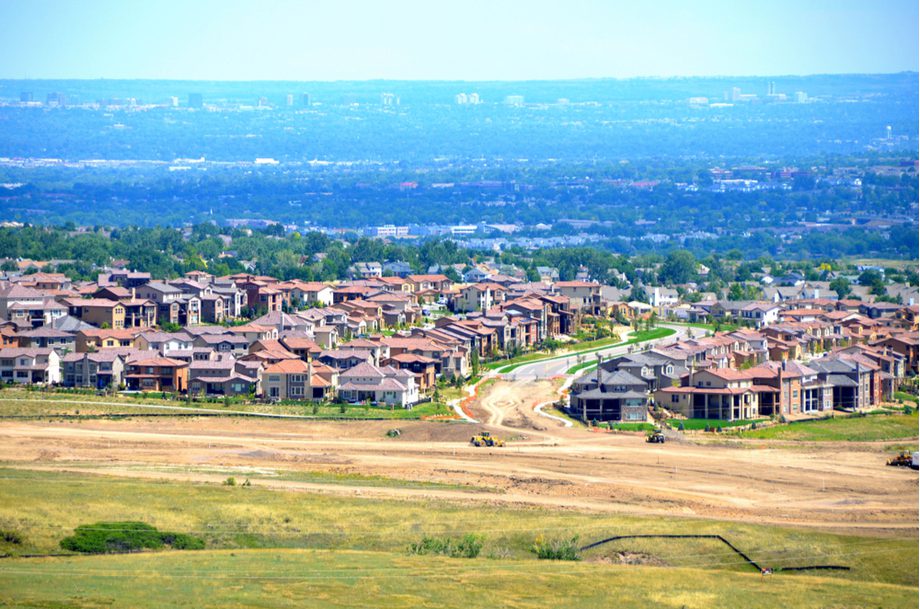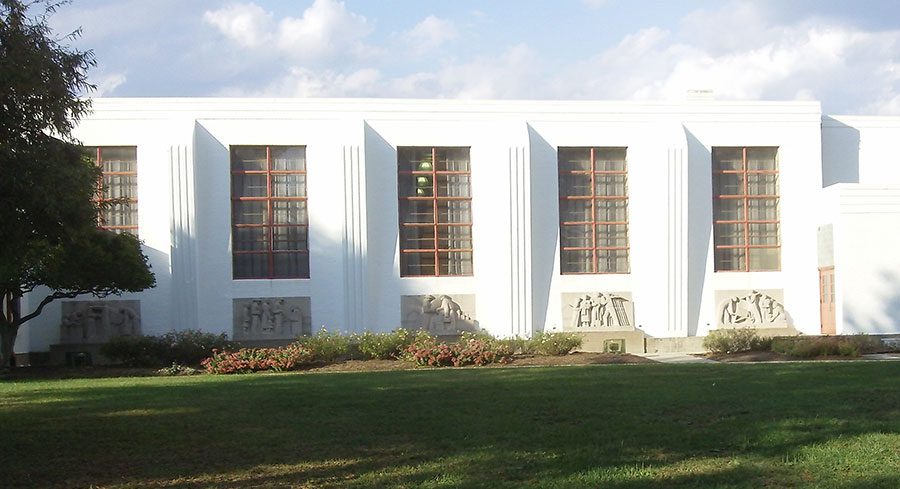Is American Sprawl Already Bankrupt?

GREENBELT, Md.—As urbanist and activist Charles Marohn spoke here last month, expounding on the “spooky wisdom” in his Strong Towns book, the setting itself made for an interesting coincidence.
Marohn addressed a mostly older crowd in Old Greenbelt’s community center, an impressive art deco building that dates to the city’s founding under a landmark New Deal program. Greenbelt was an early planned community and a public works project, so it’s an interesting place to talk about Marohn’s advocacy of incremental development, and humanity’s coevolution with the traditional city. As such projects go Greenbelt has been quite successful, though it struggles with a once-shiny, now-degraded stretch of sprawl along its major thoroughfare, sometimes dubbed “New Greenbelt.”
Perhaps it is fitting that Greenbelt was platted and built during the Depression, however, because it is the post-Depression era—not the later post-war era—that Marohn identifies as the point when we abandoned the traditional, time-honed approach to building our places. And when it comes to the poster child of urban failure, Detroit, he notes that there is at least one area of agreement: “Detroit is some very different place from anywhere in North America,” he says to laughs. Detroit, however, weathered the Depression better than most American cities, and so, mistaking correlation for causation—and no doubt with encouragement from Detroit’s primary industry—virtually all urban and suburban development henceforth copied the Motor City’s sprawling, automobile-dependent pattern (which, ironically, was itself adopted after the core city was already affluent and famous).

Marohn’s core contention is that, at a high level, that development pattern was itself what bankrupted Detroit and intensified its poverty and decline. Furthermore, because nearly every post-Depression place is built on the Detroit blueprint, America writ large can look forward in 20 or 30 years to the same fate. It’s quite a claim, but it’s based on what appear to be hard and inarguable numbers. We’ve simply built too much stuff per person, far more than tax revenues or even reasonable debt loads can ever maintain. It doesn’t help that we build so much at once—entire neighborhoods built to a “finished state”—so that the cost of maintenance all comes due at once in a tidal wave of decline.
There’s more to Marohn’s idiosyncratic “Strong Towns approach” than municipal finance, however. There’s a fascinating mediation on the traditional city as a sort of complex, adaptive organism that has co-evolved with human civilization; an emergent system with its own rules, not a fragile monoculture. There is deep, time-honed, iterative wisdom embedded in the physical forms of places as built until the 1930s. Every pre-Depression city in the world “charted the same iterative course,” starting with a dirt street and some wooden shacks, and ending, if it got that far, in magnificent architecture and bustling, well-paved thoroughfares. These cities were not created, you might say; they evolved. To Marohn, building a mature city, all at once and to a finished state, is something like trying to turn a bud into a flower. There is something about the architecture of human society that militates against it. “Why is it like this?” Marohn asks. “I don’t know. It’s complex and it’s spooky.”
We have traded the stability of the slow, incremental urban form for the quick growth of suburban sprawl, but we are not really creating wealth. Instead, we are embedding massive and unpayable expenses in the future when all those sparsely populated places need to be maintained and rebuilt. “We become poorer the more that we grow,” says Marohn. “Our cities today are like an emaciated child. There’s no meat on the bones.” The “bones” are all the visible and invisible infrastructure Marohn rattles off several times throughout his talk—roads, sidewalks, sewer lines, power lines, pipes, pumps, meters.
Part of how we got here is our strong preference for order and efficiency over chaos in a highly developed, affluent society. There is a “modest level of chaos” in more traditional built environments, but ironically, over the long term, these are much more stable places. In Marohn’s view, we have to learn to be “slightly more comfortable with a little more bottom-up chaos.” In America today, poorer neighborhoods in traditionally built but neglected places are a good example of this. “When I look at poor neighborhoods,” says Marohn, “what I see are some of the most entrepreneurial” places in America.
He suggests that it’s time to stop building, and to make better use of what we’ve already built; to break the cycle of building disposable rings of suburbs and abandoning them every couple of generations. Inner-ring suburbs and as-yet-ungentrified urban cores—places that are often in the most advanced state of decline—have the bones to be restored more than far-flung exurbs. Marohn points to a downtown that revived its businesses by replacing a vacant lot with garden sheds—incubator businesses. The streetscape was restored and entrepreneurs were given a place to test out ideas with very low risk.
I think this experiment can be found arising organically too: a lot of decayed sprawl is in fact serving this very purpose, as well as it is able to. In the D.C. metro area and beyond, the second and third lives of once-shiny strip malls are more likely to be as lively ethnic and immigrant-run businesses than as vacant lots. This dynamic, in which cheap, aging commercial space becomes an entrepreneurial resource for marginal residents, complicates the notion that the best thing we can do with old sprawl is to abandon it or level and upzone it. We are still learning whether places originally built as sprawl can, Strong Towns-like, be incrementally turned into real and more traditional urban fabrics.
Marohn’s politics, such as they are discernible, are deeply syncretic and unorthodox. His focus on profit, return, and fiscal conservatism irks some on the Left, while his focus on co-evolution, the wiring of human nature, and systems thinking can sound rather Marxian or deterministic to libertarians and mainstream conservatives. Some urbanists also find his emphasis on incrementalism and “small bets” to be insufficient. Like that famously perfect compromise, Marohn is likely to leave everyone a little bit unsatisfied. It is clear that his philosophy is an important player in the urbanist space, bringing many unique insights and ways of thinking. In particular, he presents a lot of urbanist ideas that are conventionally understood as left-leaning, and codes them in language that libertarians and conservatives can understand and accept. This is very valuable.
But is it true? Sure, numbers don’t lie. But is it really true? Is the entire American built environment really a massive liability that will have to be largely abandoned in another generation? Is each new thriving faux-downtown greenfield development really a disposable white elephant?
One criticism of the Strong Towns approach is that it traffics in “architectural determinism,” or the idea that the built environment is the primary factor in human behavior; often cited is a controversial piece on the built environment of Ferguson, Missouri in the wake of the Michael Brown shooting. But this is not really determinism, nor is it a way to pretend that race or other factors are non-issues. It is, rather, a more abstract point that should nonetheless be obvious: part of the context of everything that happens is the physical setting in which it happens. For too long we have embraced the polar opposite of architectural determinism, acting as though our national affairs take place in a disembodied Platonic realm.
As our understanding of neuroscience progresses, there is an increasingly strong case to be made that our built environment is turning us towards depression and desperation, and that any number of social and political problems may–unpredictably and indirectly—lie downstream of the physical settings of American life. If Marohn sometimes veers towards determinism, it is only because he is overcompensating for a mainstream discourse that has long treated the built environment as immaterial to anything at all.
Others, however, object to Marohn’s entire framing—his slight but very important jump from the mere observation that future liabilities exceed expected revenues to the extrapolation that virtually every American municipality is insolvent and faces something like collapse in the near future. From this extrapolation he describes growth as a Ponzi scheme, in which the insolvency problem, presenting itself as a cash flow problem, is temporarily alleviated and simultaneously compounded by new construction.
There is a pungent Korean idiom which labels this dynamic “peeing on your frozen feet”; the idea being that such a course of action temporarily relieves frostbite while worsening the frostbite that will follow. It denotes actions which simultaneously ease symptoms while worsening the ultimate prognosis. Of course, if there is always more water to drink, this might be continued indefinitely. The real problem is that our frostbitten municipalities are running out of water—which is to say, resources, greenfield land, and the ability to take on new debt.
Marohn sees a similar endpoint as James Howard Kunstler’s “long emergency”: the idea that modern industrial society faces a long period of contraction and unwinding (Kunstler ultimately blames peak oil, while Marohn sticks to auto-oriented development). Yet in 1993, Kunstler wrote, as Marohn suggests in 2019, that “the great suburban build-out is over.” Perhaps this is just alarmism; perhaps, while the facts today undoubtedly point in an ominous direction, there is some unforeseen escape hatch. If there is a 95 percent chance, for example, of a long emergency, perhaps our salvation is in that 5 percent.
There is another possibility, however, that is both more alarming and more likely: that the long emergency thesis is no longer a thesis, but a fact. I write this from the wealthiest cluster of counties in the United States, and even here our first-ring suburbs display some of the inevitable, inexorable decay that Kunstler and Marohn talk about. Outside this bubble of government-backed largesse, the decay is much more severe and widespread. Everything from trade deals to economic concentration to racism has made these problems worse, but the auto-oriented development pattern is an intensifier; it both hastens decline and complicates renewal. Most of America’s built places are not “strong, resilient, and adaptable.” It is dismal to consider that perhaps the easiest way out of this morass is total demolition. If we have built our habitats like bits of consumer junk, then perhaps it is only fitting that we dispose of them in the same way. That does not feel like very much of an answer.
Still, one does not have to accept the likely prognosis in order to accept that the disease exists. Maybe Marohn and Kunstler are wrong that the “long emergency” is already baked into the cake. But that does not make the lives of Latino immigrants or poor African Americans in decaying first-ring suburbs any better, nor does it repair rusted pipes or crumbling sidewalks, nor does it balance ailing city budgets. These problems, little attention as they may get, are matters of indisputable, observable fact. Where those facts take us is still up for debate—if we start building strong towns yesterday.
Addison Del Mastro is assistant editor of The American Conservative. He tweets at @ad_mastro.
Comments